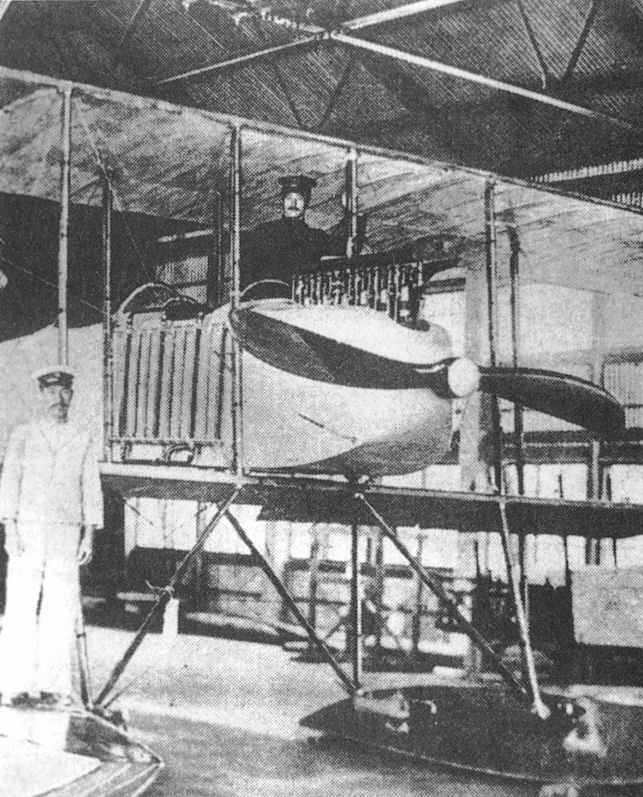R.Mikesh, A.Shorzoe Japanese Aircraft, 1910-1941 (Putnam)
Experimental Yokosho Nakajima Tractor Seaplane
By 1914 Chikuhei Nakajima was the chief designer of the Navy's Aeroplane Factory, part of the Ordnance Department at the Yokosuka Naval Arsenal. He created the first tractor float biplane in Japan, having closely studied Farman and Deperdussin aircraft designs. Completed in February 1915, this seaplane was known as the Nakajima-type Tractor. On its initial flight, when Lieut Fumio Inoue had only reached about 5m (16ft 6in) it went out of control and crashed, but a second example was built in September 1915 and successfully flight tested.
Tests of performance and reliability were made in comparison with a Yokosho-built and modified Farman seaplane. Having proved successful, a third aeroplane of the Nakajima-type Tractor was completed in June 1916, this one powered by an imported 160hp Salmson engine. The aeroplane proved to be less practical than the Ro-go Otsu-gata three-seat pusher aeroplane, the Japanese-built larger version of a Maurice Farman with modifications.
The Yokosho Nakajima Tractor was the first original design by Chikuhei Nakajima.
Single-engine twin-float tractor biplane. Wooden structure with fabric covering. Crew of two in open cockpit.
100-115hp Benz F-D six-cylinder water-cooled inline engine, driving a two-bladed wooden propeller.
Span 15m (49ft 2 1/2in); length 9m (25ft 6in); height 4m (13ft 1 1/2in); wing area 69sq m (742.734sq ft).
Maximum speed 54kt (62mph) at sea level.
Three built in 1915 and 1916.
Experimental Yokosho Ho-go Otsu-gata Seaplane
Based upon the experience gained with the Yokosho Nakajima Tractor Seaplane, two experimental reconnaissance bomber seaplanes were completed in january 1916. These single-engined aeroplanes had larger wings than the earlier type. They were powered by the 200hp Salmson engine, claimed to be the most powerful aircraft engine at that time. Once again Nakajima was the chief designer. His assistant was Sub-Lieut Kishichi Umakoshi, an aircraft designer as well as a test pilot.
The design was a success and two additional aeroplanes were built in 1919 and 1920 respectively. Both were powered by the newer 220hp Peugeot engines. All four aircraft were used for research into long-range reconnaissance and bombing. Compared with the Short Reconnaissance Seaplane imported in 1916, the japanese aeroplanes had better performance.
They were unfortunately aeroplanes without a purpose, because the japanese Navy had not yet been organized with air units. Consequently, they were never put into production for operational use although the design was accepted in june 1918 as the Experimental Yokosho Ho-go Otsu-gata Seaplane.
Single-engine twin-float unequal-span biplane. Wooden structure with fabric covering. Rearward folding wings for stowage. Crew of two in open cockpits.
200hp Salmson 2M-7 seven-cylinder water-cooled radial engine, driving a two-bladed wooden propeller (first two aircraft); 200-230hp Peugeot eight-cylinder vee water-cooled engine, driving a two-bladed wooden propeller (last two aircraft).
One bomb could be carried beneath the fuselage.
Span 21 m (68ft 10 3/4in); length 9.60m (31 ft 6in); height 4.122m (13ft 6in).
Maximum speed 52kt (60mph) at sea level; endurance 11.7hr.
Four built in 1916-1920.
Experimental Yokosho Ho-go Small Seaplane
In addition to the larger Ho-go aeroplane previously described, a smaller seaplane design was created in 1917 in an attempt to achieve better manoeuvrability. Sub-Lieut Kishichi Umakoshi was the designer, and the aeroplane was completed in 1918. Features of the Short Reconnaissance Seaplane and Sopwith Fighter Seaplane were incorporated into the design.
At that time pilots were being trained in the Farman Small (I-go) and Large (Ro-go) pusher aircraft. However, the Ho-go Small Seaplane had a higher speed, especially noticeable on take off and alighting and pilots found the aeroplane very difficult to handle. As a consequence, only one aeroplane of this type was built, but it provided valuable experience for the design of the Ro-go Ko-gata which followed.
Single-engine twin-float biplane. Wooden structure with fabric-covering. Rearward folding wings for stowage. Crew of two in open cockpit.
130hp Salmson M-9 nine-cylinder water-cooled radial engine, driving a two-bladed wooden propeller.
Span 14.60m (47ft 11 in); length 9.955m (32ft 8in); height 3.62m (11ft 10 1/2 in ).
Empty weight 884kg (1,948lb); loaded weight 1,364kg (3,007lb).
Maximum speed 67kt (77mph) at sea level; climb to 3,000m (9,843 ft) in 60min; endurance 6 1/2hr.
One built in 1918.





